D&D is a complex game, even in its streamlined fifth edition. The Young Adventurer’s Guide series, written by Jim Zub with Stacy King and Andrew Wheeler, is a great way to get kids in the range of around 8 to 12 years old (or younger, depending on their reading level) interested in this game we all love. If the Player’s Handbook is too dense and written at too advanced of a reading level for grade schoolers to read on their own, then these books can help them explore the worlds of D&D on their own. Warriors & Weapons and Monsters & Creatures, the two books in the Young Adventurer’s Guide series aren’t game books. They’re more like cultural primers on the classes, characters, monsters, and environments that make Dungeons and Dragons such an iconic touchstone of modern fantasy.
But what if there were a way to turn these two books into a game? If you’re playing with kids a bit too young to play Dungeons and Dragons with its full rules, you can use two Young Adventurer’s Guides to create a light and easy version of D&D that focuses on tactics, exploration, and learning rather than numbers and stats. Beyond just introducing kids, this “Simple D&D” game could help you introduce parents, relatives, and even coworkers who are intimidated by D&D’s manifold rules, and just want to roleplay and some puzzles together.
A Hero and their Arsenal
The first of the two Young Adventurer’s Guide books, Warriors & Weapons is a colorful, fully-illustrated guidebook of the adventurers that explore the worlds of D&D and the tools they use on their journeys, from weapons to explorer’s kits. It introduces all of the character races in the Player’s Handbook, from dwarves to dragonborn, and also includes three of the animal-inspired races from other D&D books: the feline tabaxi, the corvid kenku, and the turtle-like tortles. It does a short breakdown on the archetypes that characters of these races may fill in a fantasy story, some typical physical attributes for a member of this race, and a few questions you might want to ask yourself to see if playing a character of that race would be interesting to you.
It also includes a brief primer on half the classes from the Player’s Handbook, the six martial classes of barbarian, fighter, monk, paladin, ranger, and rogue—including a fun flowchart that helps you decide which class is best suited to your playstyle. Each class also gives you an example of an archetypal character of that class, like the legendary ranger Minsc, or the legendary fighter Bruenor Battlehammer. The six remaining classes from the Player’s Handbook, all magic-users, are conspicuously absent. Perhaps there’s a third book in the Young Adventurer’s Guide series for us in the future?
Finally, this book includes descriptions of the weapons, armor, and equipment that an adventurer might want to bring on their journey. These include many of the common weapons of D&D fantasy, but it also includes a few tools not found in the Player’s Handbook, such as the fang tian ji, a type of Chinese halberd, and the vampire hunter’s pack, an equipment pack for people who want to, well, hunt vampires!
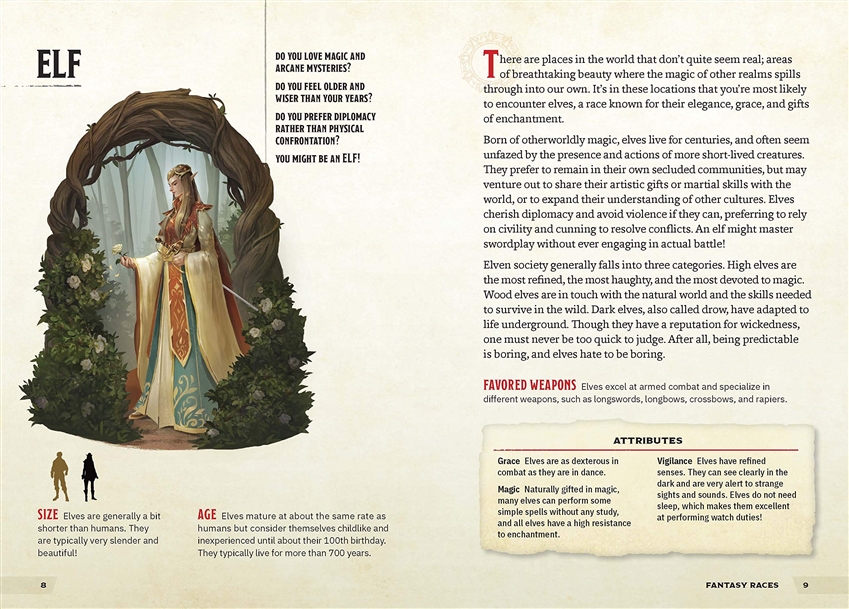
Demystifying Monsters
The second book in the Young Adventurer’s Guide series, Monsters & Creatures, is like an abridged Monster Manual with no game statistics. It details, in simple terms, what the creatures of D&D are like, their special abilities, why they’re so dangerous (or friendly!), where they make their lairs, and what an adventurer should and shouldn’t do when they suspect a monster is nearby. The monsters are given a numerical “Danger Level,” from 0 to 5 (plus the staggeringly powerful “Epic” rank above that), indicating how hard it is to defeat or otherwise overcome an encounter with one of these creatures.
This book includes some iconic examples of a particular monster, often with a higher Danger Level than the its more common counterpart. For instance, the Vampire Lord describes the typical powers of a vampire that any group of adventurers might come across. However, in the following pages, the book also describes the legendary Count Strahd von Zarovich, a mighty vampire with his own unique story and special abilities.
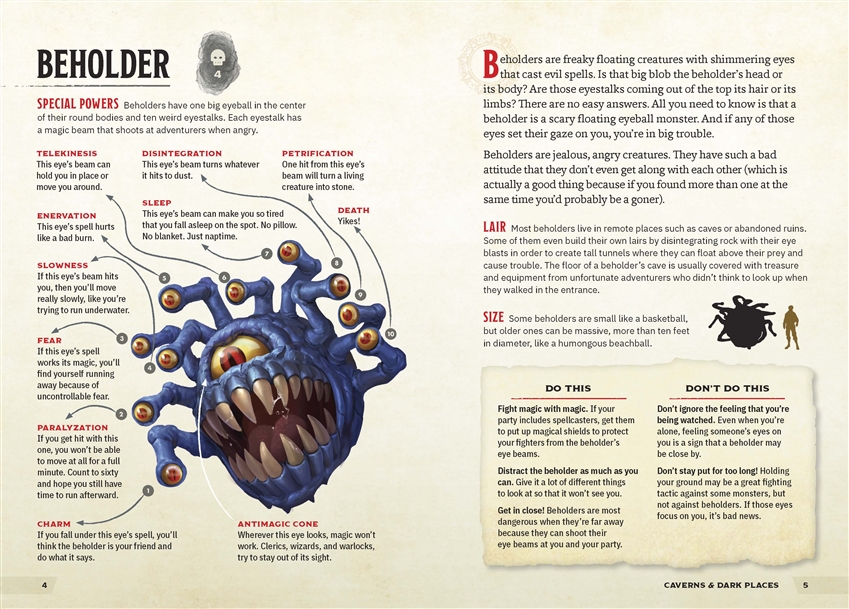
Simple D&D Rules
These “Simple D&D” rules are designed for Dungeon Masters who are already experienced with D&D, and want to introduce people who are completely unfamiliar with D&D to the game. They involve more improvisation and fewer calculations on both the part of the players and the DM. The only dice you’ll need to play “Simple D&D” are six-sided dice, something nearly every household has at least a few of.
Outfitting Your Characters with Warriors & Weapons
For a game of “Simple D&D,” there’s no reason to give any bonuses based on race; let your players choose their characters’ race be a purely aesthetic choice. If someone wants to do something that only a specific member of their race can do, like breathe fire as a dragonborn, mimic someone’s voice with their kenku mimicry, or resist the effects of a bolt of flame with their tiefling fire resistance, let them do so. However, if a player wants to do something based on their race’s Attributes, let them use each attribute once per game, as long as the player can convince you that the attribute they want to use could have an effect in the situation at hand. Humans are the exception, since they only have one attribute: Adaptable. Let humans adapt to new situations as much as they want.
Next, a player should choose their character’s class. Each class has a section on Equipment and Attributes. Leave a class’s attributes open-ended, just like you did for races. If the player wants to do something based on their class’s attributes, let them do it if they can convince you it can affect the situation at hand. For instance, if a barbarian wants to use their Rage attribute to make an extra-strong attack, let them do that! Or, they could use Rage to intimidate a prissy nobleman. Encourage creativity with these attributes! On the other hand, if a barbarian wants to use Rage to help paint a beautiful oil painting, they’ll need to work mighty hard to convince you that they can do that.
Then, take a look at the equipment that characters of that class use; that will tell you what kind of weapons and armor that class can use. Keep these in mind for later.
Now, it’s time to choose some character details, like your character’s background, their physical characteristics, their name, and what kind of clothing they wear! These details are purely for fun, and distinguish your character from others.
Finally, a character should choose their weapon, armor, and tools. If someone is playing a barbarian, that class’s attributes tell you that their character can wear light or medium armor, and tend to use hammers, axes, and two-handed swords. That player should turn to the light or medium armor sections (the barbarian class even points them towards page 80 and 82 of the book), and choose a type of armor they like. Then, turn to the swords, hammers, or axes pages of the book and choose which weapons they want. Finally, the character can pick one pack of adventuring gear from the back of the book, and one or two other items of gear that they like.
In “Simple D&D,” a character’s equipment doesn’t have any numerical benefits in combat—a character needs to have a weapon to fight and armor or a shield to defend, but as long as you have those things, it doesn’t matter what kind of weapon or armor it is. If a player calls out a specific detail in their weapon, like a glaive’s long reach or their plate armor’s thick steel plates, allow them to do one thing with that detail, like strike an enemy over a fence or absorb a heavy physical blow. Once a character has “used” a piece of equipment in a game session, they can’t use it to gain a special benefit again until next session.
Finally, a character has a level. A game of “Simple D&D” starts at Level 1, and gains a level whenever the DM decides it’s time for them to go on tougher adventures. A character’s level affects several things while battling monsters, described in the “Battling: Against Players” section, below.
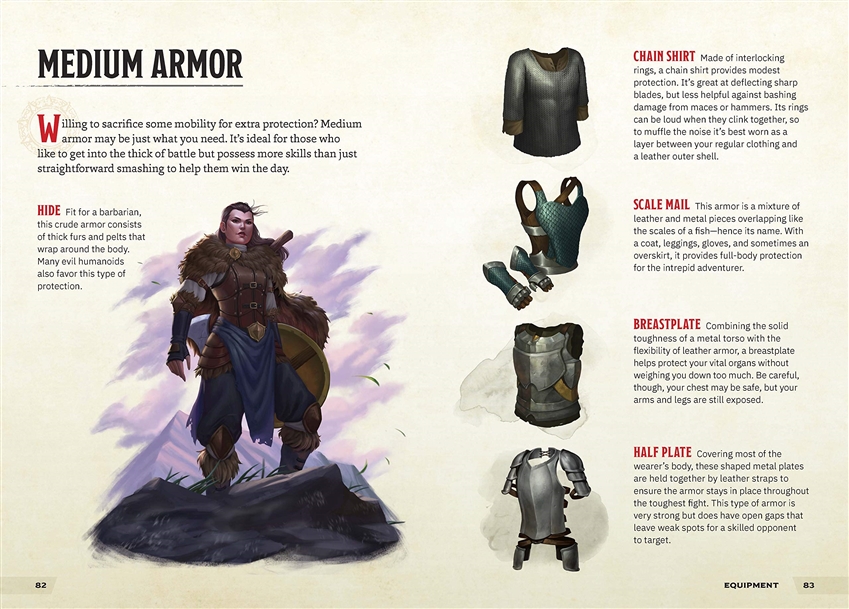
Simple D&D Rules: Battling Monsters
The core of D&D is battling monsters and exploring dungeons. In “Simple D&D,” battling monsters needs to be a quick and breezy affair, filled with creativity and excitement. When the characters encounter monsters, each player rolls a d6 to determine the order. The DM also rolls a d6 to determine when the monsters take their turn in the initiative order.
Actions
On their turn, a character or a monster can move and take an action. Since this game is played without a grid or miniatures, all movement and distances are abstracted, so use your best judgment to determine how far a creature can move; a humanoid creature generally can’t move more than 30 feet in a turn. An action is anything from attacking, trying to steal an object from a creature, using an object that requires a significant amount of effort to use, such as opening a locked door, and so on.
Whenever you’re unsure if an action will succeed, roll a d6. Easy actions succeed on a roll of 2 or higher, Medium actions on a roll of 4 or higher, and Hard actions on a roll of 6. If a character has an attribute from their race or class that makes them good at a particular action, they can use that attribute to automatically succeed. (Remember, you can only use an attribute once per game session!)
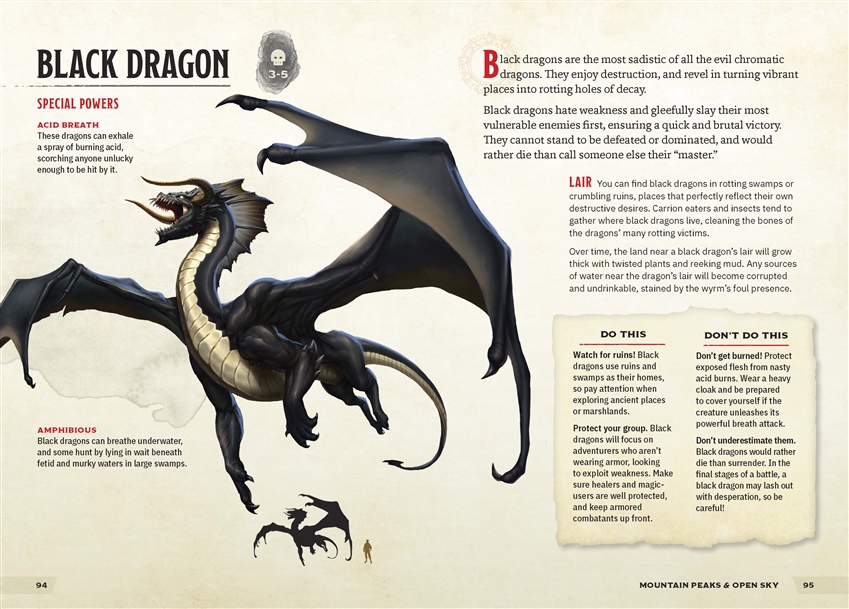
Battling: Against Monsters
A monster’s Danger Level determines all the monster’s vital statistics. In order for a player character to hit a monster, they roll a d6 to make an attack roll. If the d6 roll is equal to or greater than the monster’s Danger Level, the attack hits and deals 1 point of damage. Once the monster takes damage equal to 2 × its Danger Level, it’s defeated. A defeated monster may be killed, knocked out, or simply be terrified and surrender. The DM can determine how the monster is defeated, or you can ask the player to describe their victorious attack against the creature.
A creature with a Danger Level of Epic can only be hit if a character rolls a 6 on their attack roll, and it needs to take 20 points of damage to be defeated.
Finally, monsters have all sorts of special abilities. Like an adventurer’s attributes, a monster’s ability can only be used once per session. Like attributes, you can decide what a special ability does. Some special abilities are specifically combat based, which means you can use that ability as part of an attack. For instance, a white dragon can use its ice breath to breath a cone of freezing wind that allows it to attack two different adventurers on its turn instead of just one. Or, a vampire lord might use its summoning ability to conjure two vampire spawn to fight alongside it. Since the DM is running the monsters, they get to decide what’s a fair use of an ability. Don’t abuse this power! The DM wants to challenge the players, but you don’t want to make them feel like you’re cheating or being mean.
Battling: Against Players
A player character’s Level is very similar to a monster’s Danger Level. When a monster attacks an adventurer, it rolls a d6. If the result of the roll is equal or greater than the adventurer’s Level, that character takes 1 point of damage. Once a character takes damage equal to 2 × their Level, the character is Knocked Out. A KO’d character wakes up 1 hour later, and is cleared of all damage.
Variant: Armor Class. If you want this system to be a little more complex, then introduce the concept of Armor Class. A character wearing no armor has an AC equal to their Level. A character wearing light armor has an AC equal to their Level + 1. A character in medium armor’s AC is equal to their Level + 2, and a character in heavy armor’s AC is equal to their Level + 3. If you’re using this system, then monsters should gain a bonus to their attack rolls equal to their Danger Level.
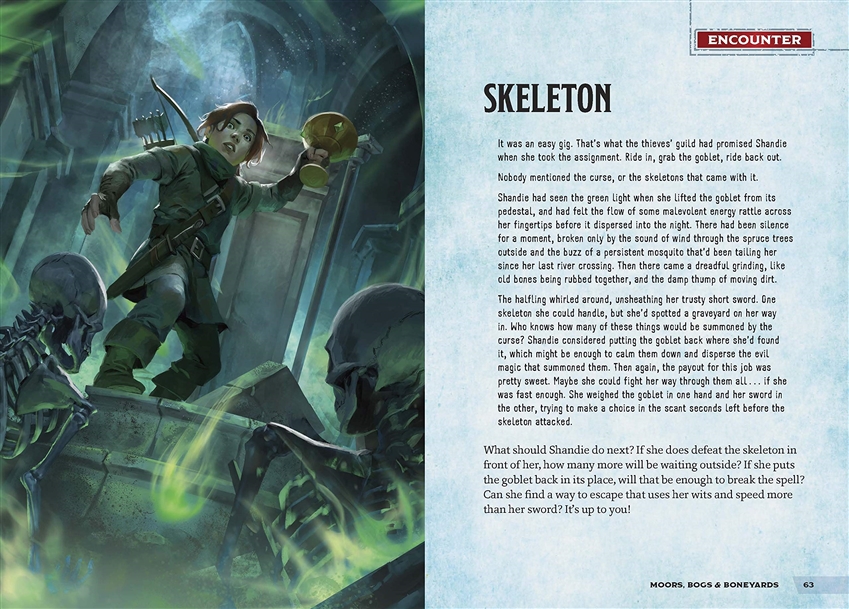
The Magical Manual of Monsters & Creatures
The role of the characters in “Simple D&D” is that of novice adventurers, who possess a magical “Manual of Monsters & Creatures” that they can consult while fighting a monster. This manual, like a Pokédex from Pokémon or other magical tomes from fiction, is filled with information about the monsters, their abilities, their lairs, and what to do or not to do while that monster is around. That’s right—it’s the Monsters & Creatures book itself! Let the players pass the book around when battling monsters, and let them look closely at its entry to learn about the monster.
The players should share the book, look closely at what it says about the monster or monsters that they’re fighting, and use that information to develop clever and imaginative strategies for how to defeat it. Reward inventive strategies or other plays that clearly show that the player has been reading and understanding the monster’s entry. For example, if the character does something using the “Do This” section of the monster’s stats, that action automatically succeeds. Their action might be attacking the beast, or tracking it through the wilderness, hiding from it, taming it, and so on. If the characters do something in the “Don’t Do This” section of the book, what they’re trying to do automatically fails.
If this system of “figure out what the best strategy is and do it” is too simplistic for your players, then they might be ready for the full D&D books!
What do you think of this “Simple D&D” idea? Would you use it to play with your kids, friend’s kids, or other young relatives? There are more Young Adventurer’s Guide books coming out soon: Dungeons & Tombs in November 2019, and Wizards & Spells in March 2020.
 James Haeck is the lead writer for D&D Beyond, the co-author of Waterdeep: Dragon Heist and the Critical Role Tal'Dorei Campaign Setting, the DM of Worlds Apart, and a freelance writer for Wizards of the Coast, the D&D Adventurers League, and Kobold Press. He lives in Seattle, Washington with his partner Hannah and their animal companions Mei and Marzipan. You can find him wasting time on Twitter at @jamesjhaeck.
James Haeck is the lead writer for D&D Beyond, the co-author of Waterdeep: Dragon Heist and the Critical Role Tal'Dorei Campaign Setting, the DM of Worlds Apart, and a freelance writer for Wizards of the Coast, the D&D Adventurers League, and Kobold Press. He lives in Seattle, Washington with his partner Hannah and their animal companions Mei and Marzipan. You can find him wasting time on Twitter at @jamesjhaeck.








-
View User Profile
-
Send Message
Posted Jul 31, 2019My friends and I were all playing AD&D 1e when we were that age. It's kind of insulting to grade school kids, honestly.
-
View User Profile
-
Send Message
Posted Jul 31, 2019A brilliant idea from a brilliant mind! This idea is perfect for people trying to start D&D groups like myself.
-
View User Profile
-
Send Message
Posted Jul 31, 2019There's nothing wrong with making a simplified version of the rules for those that might find the PHB/MM/DMG complex. You may have been able to comprehend those texts at that age, but that doesn't mean every child can. This child benchpressed 57.5 lbs in 3rd grade, that doesn't mean every child can, or assuming that other third graders wouldn't be able to do the same is insulting. Yes this is slightly an extreme, but the situation still fits.
Attempting to turn these books into an insult for children is ridiculous. They aren't saying ALL GRADE SCHOOL KIDS can only read these and not the other books, but I'm 100% certain that many kids would prefer these books over the PHB/MM/DMG due to the complexity.
-
View User Profile
-
Send Message
Posted Jul 31, 2019And just as I was wondering how to get my 7-year old daughter into the game, here you are, ready with a guide and tools.
This raises the suspicion that you're actually an aboleth, given the mind reading and all that, James.
We gave Monte Cook's "No Thank You Evil" a few tries. While a great game to get the even younger generations into the flow of adventuring, my daughter quickly found the themes a bit too childish, as she prefers browsing Mordekainen's Tome. Not sure if I should be proud, worried or a combination of both.
Ordering those books now. Thx for the timely advice!
-
View User Profile
-
Send Message
Posted Jul 31, 2019Sounds like Dungeon World lite. Which isn’t a bad thing at all.
-
View User Profile
-
Send Message
Posted Jul 31, 2019Not an aboleth a mind flayer
-
View User Profile
-
Send Message
Posted Jul 31, 2019Except kids don't need the game simplified that much, if you know the rules, you can just play, and offer suggestions like "you might want to use your investigate skill here" during the game to get them familiar. Asking them what kind of hero they want to be and building it the way they want isn't hard if you manage to find a website that automates most of it for you... if only such site existed, it could have links to the rules and materials with snazzy graphics to aid players of all skill levels. Such a site could be a goldmine.
-
View User Profile
-
Send Message
Posted Jul 31, 2019Or they can learn the rules without such a site
-
View User Profile
-
Send Message
Posted Jul 31, 2019I've an older friend with five kids who home schools, gardens, and raises chickens. Naturally with all this he and his wife find little to for each other or themselves so I suggest teaching his kids DnD to alleviate the pressure. The friction we're having is they're frightened by the art work. They're unphased by their father "processing" chickens but the diminutive, inhumanly dis-proportioned goblins are a hard pass. We're considering wrapping the books in brown paper like day drinkers on a front stoop. Its just really strange, he's done his best to shelter his children but in trying to treat them like adults he's apparently neglected their need for picture books and cartoons.
-
View User Profile
-
Send Message
Posted Jul 31, 2019Made this because your comment sparked inspiration lol
-
View User Profile
-
Send Message
Posted Jul 31, 2019Yup. That's my next adventure's villain right there. 💀
-
View User Profile
-
Send Message
Posted Jul 31, 2019I like this idea. There is a lot of basics here which could help not only kids, but any newcomer get into the game before diving into the more advanced systems.
I also noticed something that wasn't pointed out in the article-this would be an EXCELLENT guide for beginning dungeon masters to not only get a grasp on systems and encounter design, but making those encounters complex and satisfying to solve. It has an emphasis on story building and problem solving that is much valued if you run your own campaigns no matter how old you are or what system you use.
-
View User Profile
-
Send Message
Posted Jul 31, 2019Hm, I have those two books but I could not find any rules. Not that I want rules in those books. I think they are very good in explaining the basics without focussing on optimizied character build nonsense. This optimization mania of the last two to three decades is watering down the real RPG experience in my opinion. It is also the reason why I like to limit the rules options to the basic rules.
But back to my comment. The books are awesome! The English used in the books is easy to understand. This is very important for me because the kids I will game with have only a very basic understanding of the English language. They are German school kids who just started to learn English. So, not only can I support the development of their creativity but I can also support them in learning a foreign language.
So, bring in the next books in this series, the kids will love them and me too.
-
View User Profile
-
Send Message
Posted Jul 31, 2019I think you forgot a comma and a space.
-
View User Profile
-
Send Message
Posted Jul 31, 2019Very wholesome and inclusive!! Keep it up <3
-
View User Profile
-
Send Message
Posted Jul 31, 2019So, SD&D (as opposed to AD&D) is what this is?
-
View User Profile
-
Send Message
Posted Jul 31, 2019Where do you see SD&D? And if that isn't a typo, maybe that's standard d&d lol
-
View User Profile
-
Send Message
Posted Jul 31, 2019I think that's as good a name as any for "Simple D&D." =)
-
View User Profile
-
Send Message
Posted Jul 31, 2019Really awesome info here! Great way to get new people involved in a lite version to show them what it is like. And using the martial classes keeps the initial learning curve more level. Well written James!
-
View User Profile
-
Send Message
Posted Jul 31, 2019I pre-ordered both of these books (and the third book to be released soon). They are well written, and perfect for the kid who wants to play D&D but would never sit and read the players handbook. I noticed that Warriors and Weapons leaves out the more complicated classes to play. Which is good. I always tell the kids at my table that they can't play a Wizard, etc, unless they promise to read about the class on D&D Beyond or the Players Handbook. Some kids agree, many just pick another class.